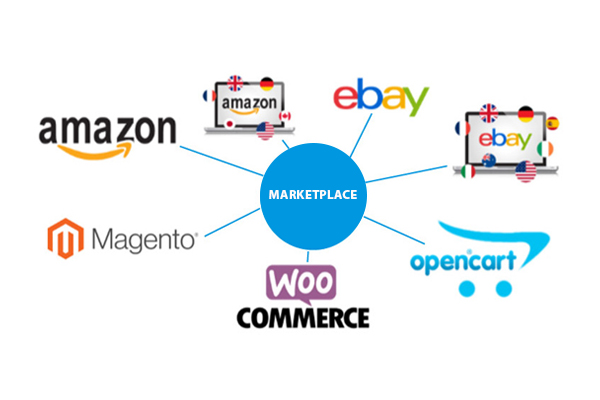Buy Marketplace Management, etsy inventory management, ecommerce marketplace management, marketplace management services, amazon marketplace management
$ 500.00 Original price was: $ 500.00.$ 99.00Current price is: $ 99.00.
Buy Marketplace Management, Etsy inventory management, eCommerce marketplace management, marketplace management services, amazon marketplace management.
The price here is per Marketplace.
Successfully selling online requires knowing the ins and outs of the channels you sell on. But when you look under the hood of a marketplace, there’s a lot to be learned.
Managing multiple marketplaces gets even more complicated—just when you think you’ve got one channel figured out, another one is bound to bring its own surprises.
Despite this, it’s always a good idea to diversify your sales channels. A good multichannel strategy protects you from being over-reliant on any one channel for 100% of your sales, plus grants you access to new audiences.
There are also steps you can take to mitigate the challenges of multi-marketplace management. Keep reading for strategies on how to simplify your work, even as you expand to new channels.
Top Challenges of Ecommerce Marketplace Management
Let’s first look at the common challenges that sellers face when it comes to managing their sales channels. Even the largest brands may find themselves combatting some of these issues, which include:
Poor inventory control – Inventory mis-management is a trillion-dollar issue each year and can stem from overselling, overstocking and other errors. Inventory issues often become inflated when multiple channels are involved, and sellers have to make sure that inventory is synced accurately across them all.
Redundant work – When you’ve got one item listed on multiple channels, you may quickly find yourself keying in the same thing over and over again when you want to make a small change or create a new listing. This not only causes burnout, but also leaves room for human error.
Listing and ranking – Each ecommerce marketplace has its own way of categorizing, organizing and ranking items that are listed for sale. Many online sellers become hyper-focused on understanding the rules of engagement for their primary sales channel (usually Amazon) and neglect to learn them for others, putting them at risk of leaving money on the table.
Demand forecasting – Of course, when you’re selling on multiple sites, you need to have enough inventory to fulfill all the orders. But predicting how many sales you’re going to make is tough, and you’ll have to account for varying lead times, production costs and storage fees.
Change management – Ecommerce never sits still. Likewise, marketplaces are constantly updating their algorithms and listing requirements to improve the shopping experience on their sites. Many sellers today lack an efficient, scalable solution for this, and their businesses are disrupted whenever a channel makes a sudden change.
Strategies for Making Your Job Easier
Given the above challenges, what can you do to alleviate the stress of online selling? Take a look at these tips and see what you can put into motion.
1. Centralize Your Catalog
The easiest way to manage your multichannel listings is to have your product data located in one place. This creates one source of truth for your team to reference. It also saves you the hassle of logging into each marketplace individually in order to post a product up for sale or to perform (what should be) quick tasks.
Beyond this, you’ll want to be able to centrally manage your inventory, analytics and other essential apps (such as your WMS). This can be achieved through a multichannel ecommerce platform, which makes sure that all of your apps communicate with one another.
Multichannel platforms can range drastically in their capabilities, as well as the channels they support. You can use this checklist to track your requirements and keep notes about every platform you demo.
2. Standardize Your SKUs and Listings
Aside from having your catalog located in one place, you’ll want to define a standard way of formatting your SKU codes. This will make it easier for your internal team to track, reference and use SKUs to their advantage when managing your inventory.
SKU codes can be arranged in a variety of ways. One popular method is to denote the brand first, then describe the style, color, size and other attributes that your customers or vendors care most about.
example of a sku naming formula
Keep in mind that SKUs are different for UPC codes. UPCs should be purchased directly from GS1 and are not readable by humans, whereas SKUs are custom to your company. SKUs can be paired with a barcoding system (as an example) so that you keep track of what’s in your warehouse and what needs to be ordered. SKUs can additionally be helpful when you’re using a listing software and need to quickly search and pull up a listing to edit.
Another thing you’ll want to standardize is your process for creating titles, descriptions and other components of your product listings depending on the channel (and/or category). Each marketplace has unique guidelines. Observe these recommendations in order to put yourself in the best position for ranking and make it easy on your customers to explore your catalog.
3. Invest in Listing Automation
Listing automation is especially critical when you’re a multichannel seller. Aside from improving efficiency in your day-to-day work, it can prevent or help to quickly resolve listing errors before they hurt your sales.
Zentail, for example, automatically categorizes and formats product data for you. This ensures that your listings are mapped properly on each channel and optimized for marketplace SEO. You can also spend more time tweaking your copy, prices and/or advanced attributes as opposed to getting the basic data in to further increase your odds of being ranked on the first page.
Read Also: The Listing Quality Flywheel: Explained
Listing automation tools range from free to premium solutions. The most advanced solutions offer one-click listing in addition to bulk editing, business rules and pricing management. Beware of platforms that advertise multichannel automation but still require you to manually create your own templates per channel. Find a solution that lives up to its promises and can safeguard your product data from errors.
4. Leverage Kits and Bundles
Many marketplaces these days are sensitive to price parity. In other words, your channel may suppress your listing if it finds that your product can be found at a significantly cheaper price on any other site (whether from you or another seller).
One way to get around this limitation, plus increase your average order value (AOV), is to experiment with multipacks and bundled products. These allow you to list your products as separate SKUs, each at different price points.
Both kits and bundles additionally offer a competitive edge. Customers will feel like they’re getting extra value for the money they spend, and potentially be more willing to try new products when bundled together with their favorite products.
Pro tip: Other ways to avoid violating price-parity rules include only offering a certain portion of your catalog on some channels. For example, you could sell your newest products on Amazon, and any overstock or last-season models on eBay.
5. Invest in a Good Inventory System
As mentioned earlier, inventory could easily get out of hand when you’ve got multiple ecommerce channels to keep your eye on. Unlike brick-and-mortar stores, your online channels are open 24/7 and therefore present new challenges to inventory management.
Other factors, such as whether you sell finished goods versus manage the entire manufacturing process, will affect your requirements for an inventory system. At minimum though, you’ll need something that syncs your inventory across all of your channels.
This means that when an order comes in on any channel at any time, your system will know to reserve the right amount of stocks and deduct it form the available quantities on other channels.
Other than this, you may find that you need extra assistance forecasting demands, managing purchase orders, managing suppliers, and more. If so, there’s an inventory management system out there for you—you’ll just have to do your due diligence and research all your options.
6. Register Your Brand (If Applicable)
The ugly truth to selling on marketplaces is that there are counterfeiters and unscrupulous competitors on every channel. This has been a known issue on Amazon, which has already cracked down on billions of counterfeit products in the past.
To further protect your brand, you’ll want to register your brand wherever possible. Amazon, for instance, maintains a Brand Registry that enables brand owners to police their ASINs, report any fraudulent activity and access advanced marketing tools.
Similarly, Walmart’s Brand Portal helps brands identify (and fight against) IP infringement within the marketplace. Needless to say, registering your brand is a responsible step towards safeguarding your brand on channels where millions of other sellers compete.
Free Ebook: 6 Brand Control Strategies for Marketplace Merchants
7. Consider Outsourcing Fulfillment
On channels like Amazon, it’s almost a necessity to participate (at least in part) in a third-party fulfillment program. Nearly three-quarters of all Amazon Sellers use FBA, not because they can’t fulfill orders on their own but because winning the buy box or first-page status relies on having Prime status.
On other channels, you may need to outsource fulfillment in order to keep up with seller performance standards, like two-day shipping expectations or fast customer service.
With all that said, you never want to put all your eggs in one basket. Use FBA and other marketplace programs when necessary, but look for a 3PL or someone detached from the marketplaces to help you achieve fast shipping too. Don’t leave yourself vulnerable to surprises, such as when Amazon FBA pulled the plug on non-essential products when the COVID-19 pandemic hit.
The Bottom Line
Ecommerce marketplace management requires juggling dozens of different responsibilities, requirements and strategies all at once. Fortunately, the above tips can help to alleviate the burden on your shoulders.
Be the first to review “Buy Marketplace Management, etsy inventory management, ecommerce marketplace management, marketplace management services, amazon marketplace management”
You must be logged in to post a review.
Related products
Amazon SEO
Buy Amazon PPC, Amazon sponsored products, Amazon sponsored ads, Amazon campaigns Services




Reviews
There are no reviews yet.